There exist numerous flowers that captivate the attention of hummingbirds, but it is imperative to locate plants that can endure and prosper under specific weather conditions. Should the climate be excessively hot or cold, these plants may wither away or fail to produce enough flowers for hummingbirds to extract nectar from.
The United States is divided into 13 zones based on the average minimum temperature, as depicted by the USDA plant hardiness zone map. Furthermore, within each state, distinct zones can be found. Plants flourish in various zones and can withstand minimum temperatures, but they struggle to survive if the cold becomes too extreme.
In New Hampshire, winters are frigid while the summers are warm and pleasant without excessive heat. Central and southern parts of New Hampshire experience warmer temperatures and fall within hardiness zone 5, while northern New Hampshire is the coldest, residing in zones 4 and 3.
To account for plants sensitive to extreme heat, the American Horticultural Society devised the plant heat-zone map, which indicates the average number of days an area experiences temperatures above 86 degrees Fahrenheit.
In New Hampshire, the number of hot days is relatively limited, placing the state within zones 2 to 5 on the plant heat zone map. Consequently, it is the harsh winters that have a more significant impact on hummingbird plants in New Hampshire rather than excessive heat.
To ensure that these plants not only bear beautiful, nectar-rich flowers cherished by hummingbirds but also thrive in New Hampshire’s weather conditions, they have been carefully evaluated against cold and heat zones in the state.
It is important to note that plants listed under cold zone 5-6 will not survive the colder winters in zones 3 or 4 of New Hampshire unless provided with adequate protection.
Therefore, it is advised to cultivate as many of these flowers as possible to entice hummingbirds in the state of New Hampshire.
Hummingbird Plants for Hardiness Zones 3 and 4 in New Hampshire:
1. Nasturtiums
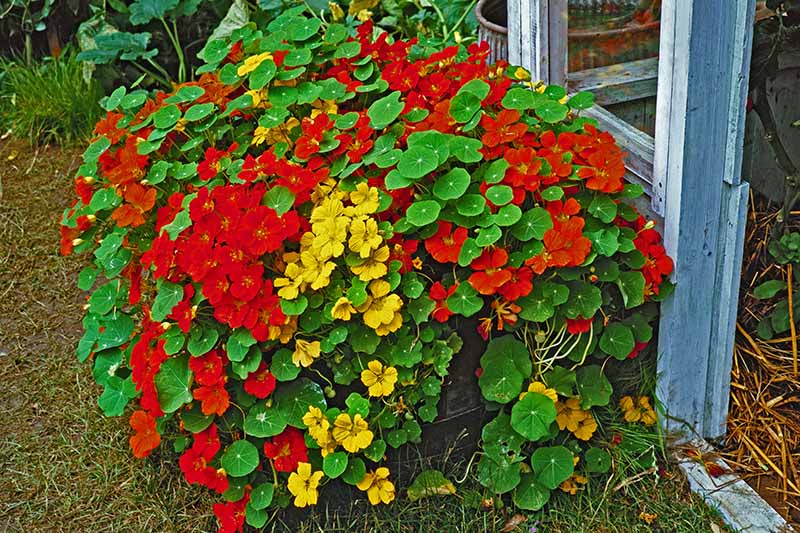
Nasturtiums are trailing flowers that possess edible qualities, making them perfect for creating hanging baskets that attract hummingbirds due to their abundant nectar and uniquely designed deep flowers.
Usually grown as annuals, these plants come in trailing or bush types. Sow the seeds just after the final frost outdoors, and ensure they receive proper watering throughout the growing season while removing spent blooms.
Common Name: Nasturtiums
Scientific Name: Tropaeolum
Growing Zones: 2-11
Sun: Full
Soil: Well-drained
Colors: Red, orange, yellow, pink
Height: 1-10 feet
Spread: 1-3 feet
Plant Type: Annual
2. Zinnia

Zinnias are flowering shrubs native to North America’s scrublands and dry grasslands. They belong to the Heliantheae genus, a part of the larger Asteraceae family.
Zinnias can be classified into three main types based on their petal structure. Single-flowered zinnias possess a single row of petals with a visible center. Double-flowered zinnias consist of multiple rows of petals with no visible center, while semi-double-flowered zinnias feature numerous rows with visible centers.
Zinnia elegans, known for its tall stems and vibrant colors, is considered a classic variety, highly favored in backyard gardens. Reaching a height of 4 feet, it produces an abundance of brilliantly colored flowers from early summer until frost, attracting pollinators such as butterflies and, of course, hummingbirds.
Growing zinnias is a straightforward process, but it is important to plant them directly in the desired location since they do not respond well to transplantation. Once established under full sun and well-drained soil, these plants will bless your garden with their vivid blooms for an extended period.
Common Name: Zinnea, Zinnia
Scientific Name: Zinnia elegans
Growing Zones: Annuals in 2-8, Perennials in 9-11
Sun: Full sun
Soil: Neutral to slightly alkaline, well-draining
Colors: White, yellow, orange, pink, red, purple
Height: 1-4 feet tall
Spread: 12-18 feet wide
Plant Type: Annual, Perennial Shrubs
3. Agastache
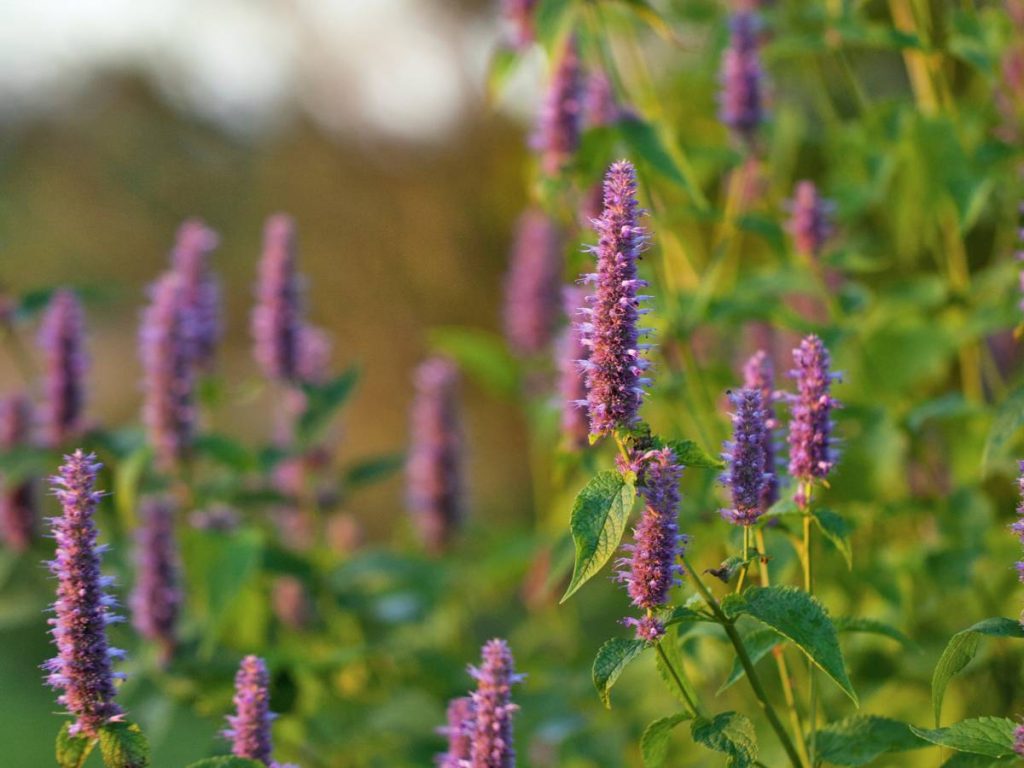
Agastache, pronounced as “ah-GAH-stuh-kee,” encompasses a collection of aromatic herbaceous perennials, with approximately 22 different species, most of which are indigenous to North America. They are commonly referred to as “hummingbird mints” and “Giant hyssops” and can also be utilized in herbal tea production.
Agastache flowers possess a distinctive quality that captivates hummingbirds. These flowers, about 3 to 4 inches in length, stand out among the leaves due to their fuzzy appearance, composed of numerous tiny flowers clustered together. The vibrant purple and red hues of Agastache flowers are particularly appealing to hummingbirds, who cannot resist flocking to these blossoms, especially when they are in full bloom during the summer.
The most effective method of cultivating Agastache flowers involves starting them indoors in May and then transplanting them into flower beds during the summer. They require full sun exposure and regular watering during their establishment period. Once they have taken root, they exhibit excellent drought tolerance and can thrive without constant intervention.
Agastache plants are well-suited to desert climates, enabling them to endure scorching temperatures. Consequently, excessive watering should be avoided to prevent root rot. Instead, provide them with occasional splashes of water and allow them to dry out naturally.
Common Name: Agastache, Hummingbird Mint, Hyssop
Scientific Name: Agastache
Growing Zones: 3-10
Sun: Full Sun
Soil: Lean soil, well-drained
Colors: Blue, purple, red, orange, pink, white
Height: 3-5 feet tall
Spread: Varies
Plant Type: Herbaceous perennial
4. Morning Glory
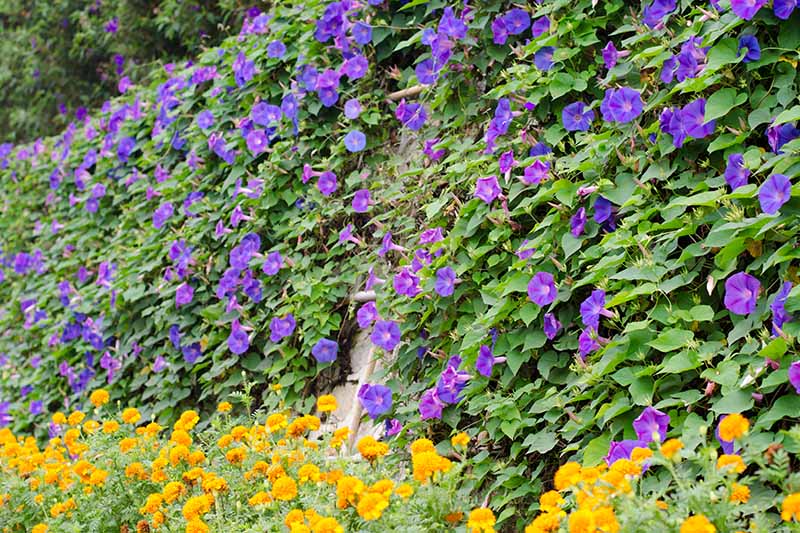
Morning Glory refers to over 1,000 species of flowering plants belonging to the Convolvulaceae family. These plants earned their name due to their tendency to open their vibrant flowers early in the morning and close them as the day heats up. However, certain species within the Morning Glory family bloom during the night instead of the day, such as Ipomoea alba.
Morning glory flowers are characterized by their vivid and colorful blooms, fast-growing vines, lush green foliage, and resilience in poor, dry soils. They are often found twining around arbors or adorning the exterior walls of houses with the aid of trellises.
One notable Morning Glory species that attracts hummingbirds is Ipomoea purpurea, boasting bright purple, trumpet-shaped flowers and heart-shaped leaves that unfurl in the morning and close in the afternoon. These flowers bloom from early summer until early fall.
While Morning Glory is an annual vine, it may act as a perennial in more temperate climates. It is crucial to provide Morning Glories with full sun exposure, approximately 8 hours of sunlight each day, to ensure optimal blooming.
Care should be taken to prevent the fast-growing vines from becoming invasive, and their seeds are toxic if ingested, thus necessitating caution around children and pets.
Common Name: Morning Glory, Common Morning Glory
Scientific Name: Convolvulaceae family
Growing Zones: 2-11
Sun: Full sun
Soil: Moist, well-draining
Colors: White, pink, purple, blue
Height: 6-10 feet tall
Spread: 3-6 feet wide
Plant Type: Annual
5. Impatiens
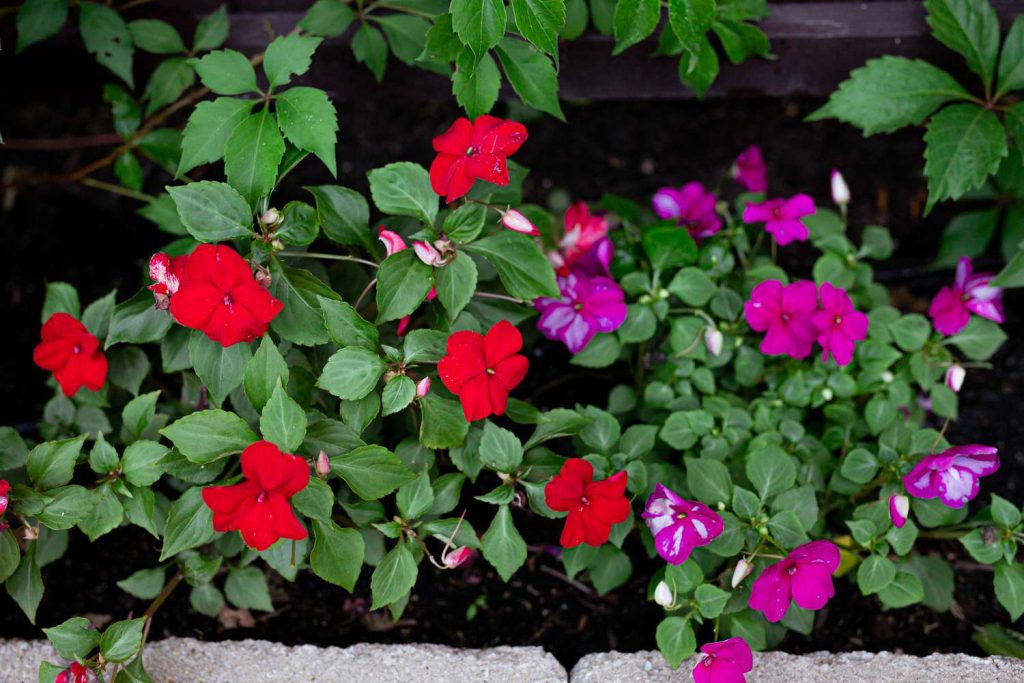
Impatiens, vibrant annual flowers, serve as excellent additions to shaded areas, bringing brightness and attracting hummingbirds.
These flowers thrive in moist, well-draining soil and are well-suited for deep shade, making them suitable for hanging baskets on porches.
Typically, Impatiens are grown from nursery-bought plants arranged closely together to create a dense mat of flowers and foliage.
Seeds can also be collected from the plants and sown indoors 10 weeks before the last frost, as they take considerable time to flower. Alternatively, cuttings can be taken in the fall and grown indoors until the frost has passed.
Common Name: Impatiens, Jewelweed, Touch-me-not, Snapweed, Patience
Scientific Name: Impatiens
Growing Zones: 2-11
Sun: Shade or partial shade
Soil: Rich, well-draining
Colors: Red, pink, purple, yellow, coral
Height: 6-36 inches
Spread: 1-3 feet
Plant Type: Annual
6. Columbine

Columbines rank among the top plants for attracting hummingbirds due to their wide array of vibrant colors and their ability to thrive in partial shade.
Columbine, also known as Aquilegia, represents an elegant perennial plant with spiky, bell-shaped blooms ranging from 3 to 6 inches in length. There are numerous varieties of columbine, but most prefer to grow in areas with partial shade to full shade and bloom as early as spring, making them an ideal choice for attracting hummingbirds.
These hardy flowers not only tolerate shade but also exhibit drought tolerance and resistance to deer. Columbine seeds can be sown directly into the ground in spring, and if left undisturbed at the end of the flowering season, they will self-seed. Alternatively, seeds can be sown indoors 6 to 8 weeks before the last frosts for an early start. However, it is important to note that seed-grown plants may not produce flowers until their second year.
Common Name: Columbine, Aquilegia
Scientific Name: Aquilegia
Growing Zones: 3-9
Sun: Full sun to partial shade
Soil: Neutral pH, moist but not saturated
Colors: Red, pink, blue, orange, white, yellow
Height: 1-3 feet
Spread: 1 foot
Plant Type: Perennial
7. Coneflower
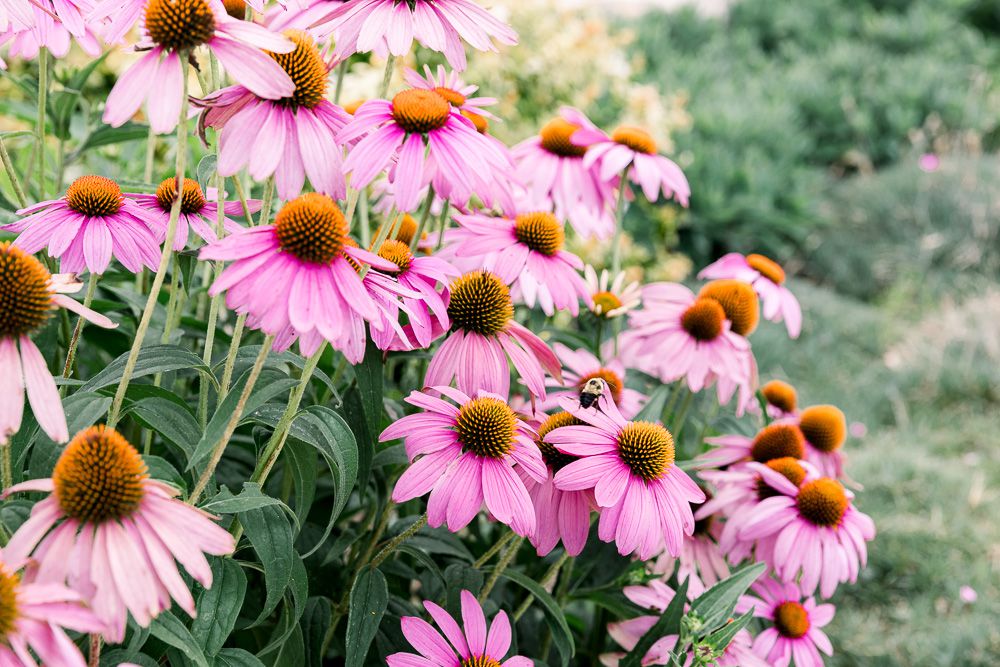
Coneflower, also known as Echinacea, belongs to the daisy family (Asteraceae). With its ten species, these flowers display downward-pointing petals once the central flower head opens, forming a cone shape. The most common and ornamental variety is Echinacea purpurea, native to eastern North America.
Coneflowers showcase large, approximately 6-inch-wide flowers on stalks that can reach up to 5 feet in height. They are available in various colors, including pink, red, orange, yellow, and white, depending on the specific variety. These flowers thrive in full sun and well-drained soil. Their brightly colored petals, particularly the reds and purples, attract hummingbirds and other pollinators like bees and butterflies due to their nectar-rich central cones.
Common Name: Coneflower
Scientific Name: Echinacea
Growing Zones: 3-9
Sun: Full sun
Soil: Varies
Colors: White, yellow, orange, pink, red, purple, green
Height: 2-5 feet tall
Spread: 1 ½-2 feet wide
Plant Type: Perennial
8. Penstemon

Penstemon, a genus within the plantain family (Plantaginaceae), encompasses over 250 ornamental flowering plants, similar to snapdragons and foxgloves. It is often referred to as “Beardtongue” due to the tuft of small hairs on the pollen-free stamen protruding from the flowers.
Penstemon offers a wide range of species and varieties, differing in size and color. However, they all share common traits: drought tolerance, attraction to hummingbirds and bees, low maintenance, and vibrant blooms that add beauty to any garden. These flowers bloom in early summer, featuring spires and colorful clusters of tubular flowers in shades of blue, purple, red, orange, white, pink, and yellow.
Hummingbirds are particularly drawn to Penstemon due to their bright colors and nectar-rich flowers. For optimal growth, plant Penstemon in a location where they receive full sunlight. These plants prefer lean, fast-draining soil and can tolerate drought. Watering should be limited to avoid root rot, allowing the plants to thrive naturally.
Common Name: Penstemon, Foxglove Beard-tongue, Talus Slope Penstemon, White Beardtongue
Scientific Name: Penstemon
Growing Zones: 3-9
Sun: Full sun
Soil: Lean, fast-draining soil
Colors: Blue, purple, red, orange, white, pink, yellow
Height: 6-12 inches, 1-3 feet, 3-8 feet
Spread: 8-20 inches
Plant Type: Perennial
9. Summersweet
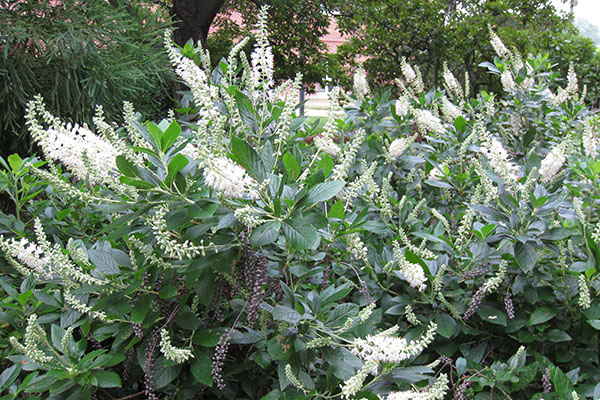
Summersweet, scientifically known as Clethra alnifolia, is a flowering shrub that adds beauty to your garden while attracting hummingbirds.
Clethra alnifolia, also referred to as Coastal Sweet Pepperbush, is native to eastern North America and is commonly found in wetlands, ponds, and stream edges. These shrubs feature vertical spikes of spicy-smelling white flowers against dark green foliage. In autumn, their leaves turn yellow or gold. Additionally, they produce brown seed capsules resembling peppercorns that drop after the flowers bloom.
Summersweet flowers bloom from July to August, displaying 2 to 6-inch-long white or pink flowers. Their fragrance is enticing to butterflies, hummingbirds, and other pollinators. During autumn, the pepper-like seeds attract birds.
Since Summersweet naturally grows in coastal regions, it thrives in moist to wet soil and shade. These plants prefer nutrient-poor soil and exhibit excellent tolerance to salty air. Summersweet requires minimal care, but it’s advisable to give them ample space to spread. Maintain soil moisture and prune old branches in spring for new growth and reshaping.
Common Name: Summersweet, Coastal Sweet Pepperbush
Scientific Name: Clethra alnifolia
Growing Zones: 3-9
Sun: Full sun or partial shade
Soil: Moist to wet soil, slightly acidic
Colors: White, pink, or rose-colored
Height: 4-8 feet tall
Spread: 4-6 feet wide
Plant Type: Perennial, Deciduous shrub
10. Yarrow
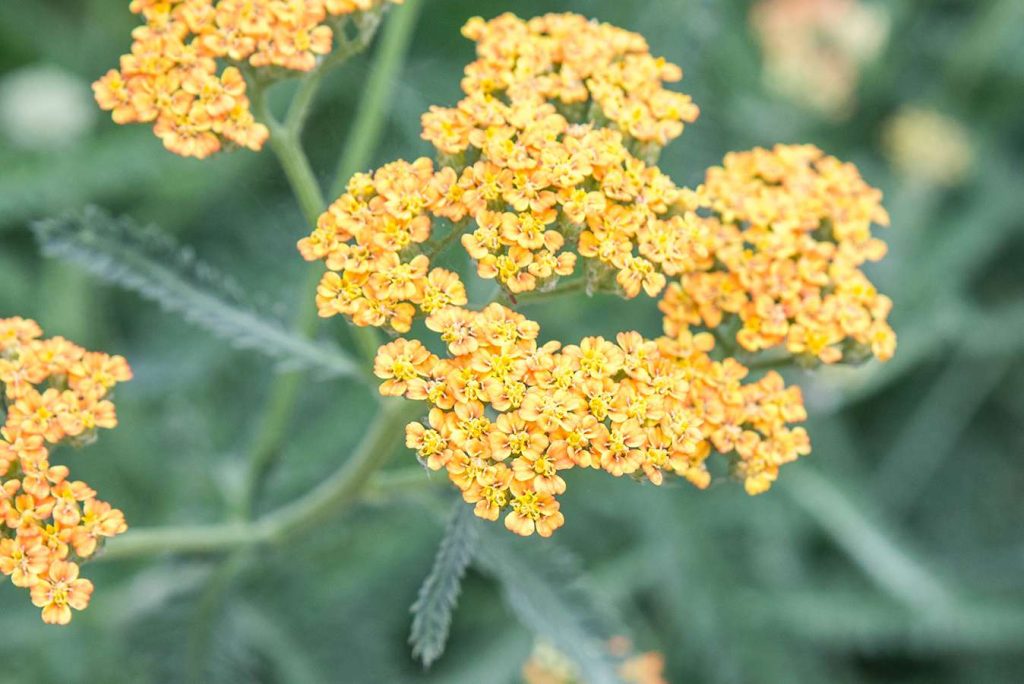
Yarrow, scientifically known as Achillea millefolium, carries intriguing folklore behind its name. “Achillea” derives from the Greek hero Achilles, who supposedly used yarrow to treat his soldiers’ wounds. “Millefolium” translates to “thousand leaves,” referencing the feathery appearance of its finely divided leaves.
Yarrow boasts clusters of tiny flowers in white, yellow, pink, or red, depending on the variety. These flowers grow tightly on the end of the spike, ranging from 15 to 40 flowers per cluster. Yarrow plants feature evenly distributed, fern-like leaves along the stem, with larger leaves near the bottom and middle. The aromatic leaves are visually appealing.
Apart from their beauty, yarrow flowers attract hummingbirds, bees, and butterflies. These plants are relatively easy to grow, thriving in full sun and well-drained soil. Yarrow is not only admired for its flowers but also utilized in traditional medicine for various purposes, such as treating wounds, burns, colds, fevers, and headaches.
Common Name: Yarrow, Common Yarrow, Milfoil, Nosebleed, Thousand-leaf
Scientific Name: Achillea millefolium
Growing Zones: 3-9
Sun: Full sun
Soil: Sandy, loamy, clay, well-draining
Colors: White, yellow, pink, red
Height: 2-3 feet tall
Spread: 2-3 feet wide
Plant Type: Perennial
11. Butterfly Weed
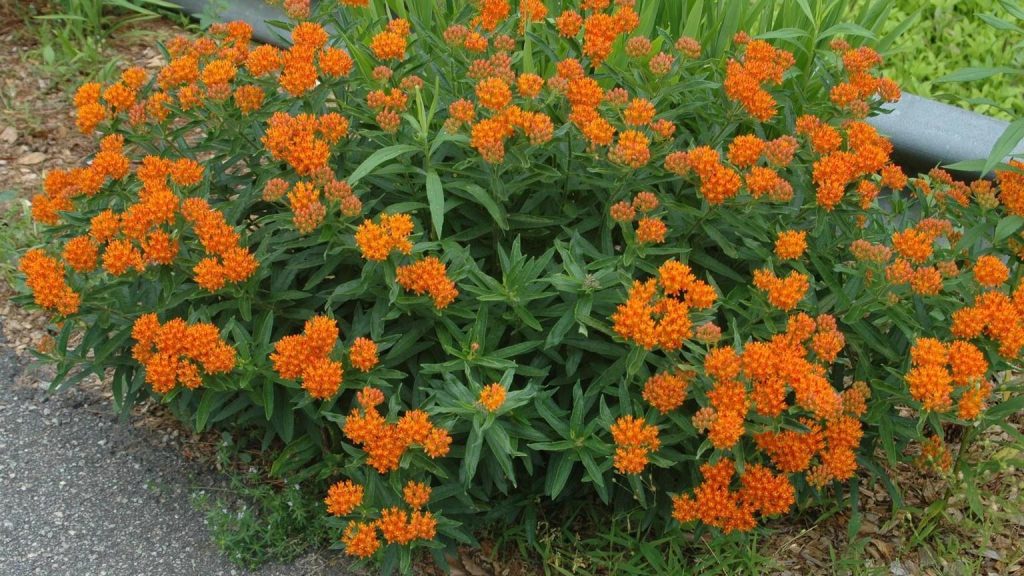
Butterfly weed, scientifically known as Asclepias tuberosa, is a bushy and visually striking plant that serves as a haven for hummingbirds in your garden.
Also referred to as Pleurisy Root due to its historical use in treating pleurisy and other pulmonary ailments, Butterfly Weed belongs to the milkweed family (Asclepiadaceae). Despite its name, it does not produce a milky sap. This vibrant plant displays long, bright red tubular flowers specifically designed to accommodate hummingbirds’ long bills.
Butterfly weed is a herbaceous perennial that blooms in late summer. The bright red flowers form terminal spikes and attract hummingbirds, along with other pollinators. These plants prefer moist soil that does not dry out and are not tolerant of drought. When cultivating butterfly weed in pots, it’s best to place them in trays of water that can be easily replenished.
Common Name: Butterfly Weed, Butterfly Flower, Orange Milkweed, Pleurisy Root
Scientific Name: Asclepias tuberosa
Growing Zones: 3-9
Sun: Full sun to partial shade
Soil: Rich, moist
Colors: Red, pink, white
Height: 2-4 feet
Spread: 1-2 feet
Plant Type: Perennial
12. Hydrangea
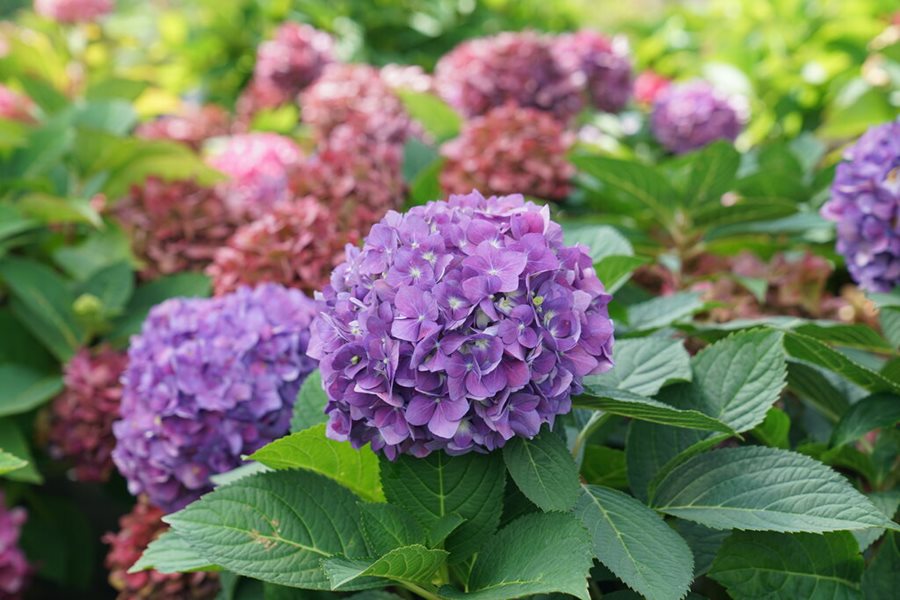
Hydrangeas, with their enormous flower heads, provide a delightful touch to shaded areas of your yard. These showy plants prefer shade, especially in the afternoon, as they do not fare well in excessively hot conditions.
Hydrangeas thrive in moist soil, necessitating a generous watering once a week, particularly in dry conditions. Pruning should be done after the flowers have withered during winter.
These beautiful flowers bloom from spring to fall, adding interest to your garden even during winter months.
Common Name: Hydrangea
Scientific Name: Hydrangea
Growing Zones: 3-9
Sun: Full sun to shade
Soil: Fertile, well-draining
Colors: Pink, red, white, blue, green
Height: 3-15 feet
Spread: 2-12 feet
Plant Type: Perennial
13. Veronica
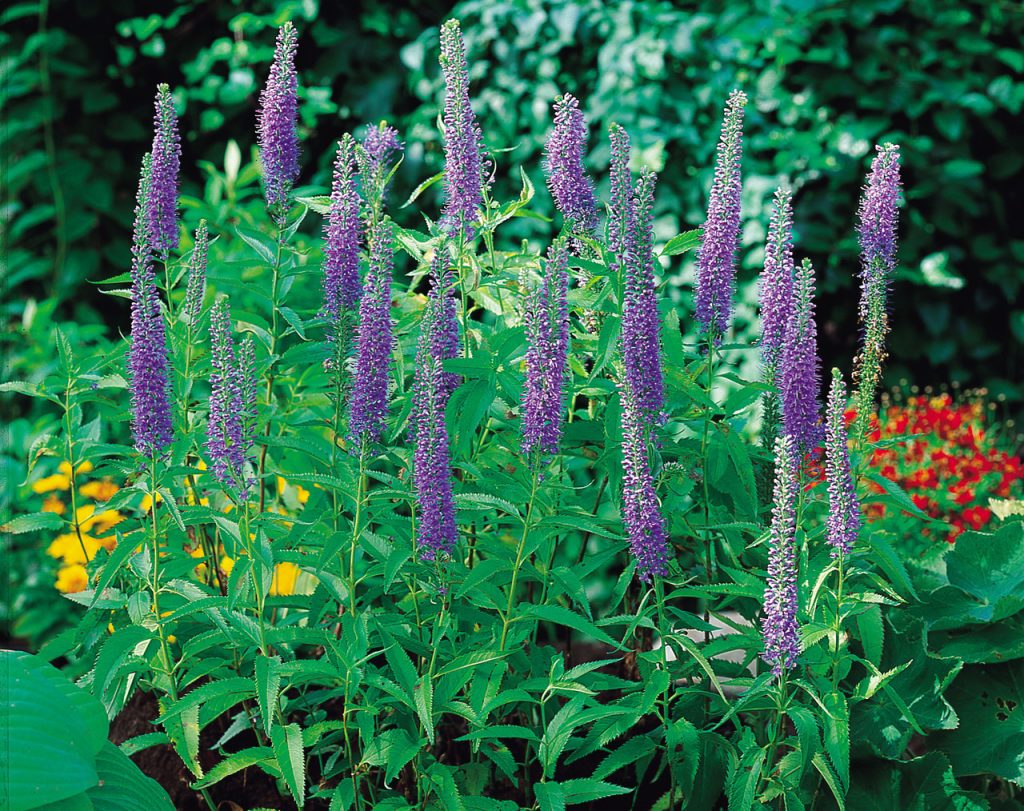
Veronica is a genus comprising approximately 500 species of flowering plants, making it the largest within the Plantaginaceae family. These herbaceous perennials or annuals are primarily native to the temperate Northern Hemisphere.
Veronica plants come in various varieties, including low-growing options suitable as ground covers that bloom in spring and tall, upright plants with vertical flower spikes that bloom in summer.
One popular variety is Veronica spicata, known for its colorful vertical spikes of tiny flowers. These flowers clump together at the end of the spike, displaying shades of white, pink, purple, and blue. Hummingbirds, bees, and butterflies are highly attracted to the vibrant blooms.
Veronicas are resilient plants that can tolerate different soil types. They are generally pest-resistant and benefit from deadheading to extend their flowering season. These plants thrive in full sunlight and require regular watering while establishing themselves. Once established, they exhibit drought tolerance.
Common Name: Veronica, Speedwell
Scientific Name: Genus Veronica from the family Plantaginaceae
Growing Zones: 3-11
Sun: Full sun, partial shade
Soil: Well-drained
Colors: White, pink, purple, blue
Height: 6 inches to 3 feet tall
Spread: 6 inches to 2 feet wide
Plant Type: Perennial
14. Bleeding Heart
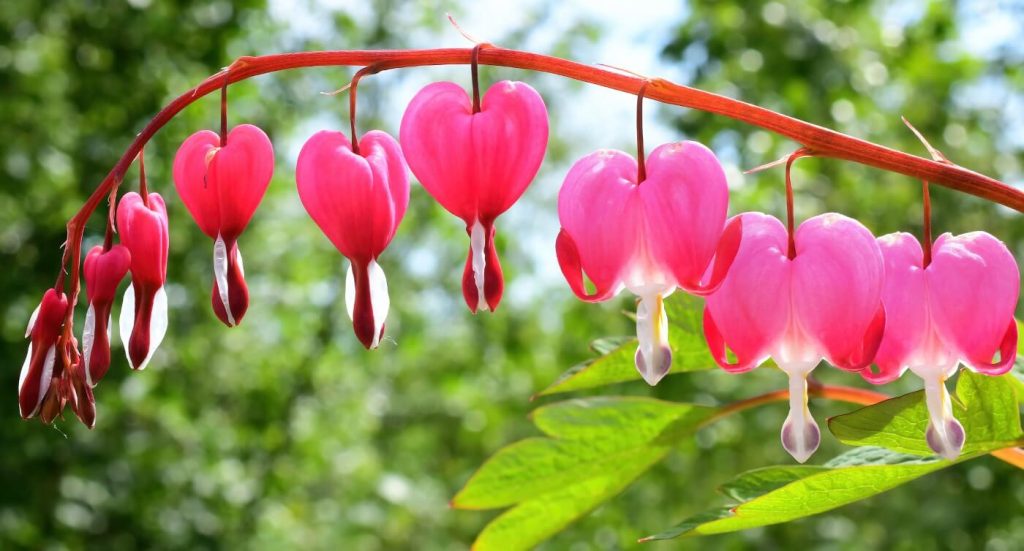
Bleeding heart, scientifically known as Dicentra spectabilis, enchants with its delicate, heart-shaped flowers that bloom during the spring season. These perennial plants require minimal maintenance and can be planted in full sun or partial shade.
Bleeding hearts make an excellent addition to shady corners, and their arching flowers create a stunning visual when cascading from hanging baskets.
While they may die back in extreme heat or excessive sun, the roots remain dormant and regrow the following year. Adequate watering is essential during the growing season, maintaining moist but not overly wet soil.
As fall approaches, the foliage turns yellow, indicating a natural dormancy period. At this point, the plant can be cut back, and it will regrow.
Common Name: Bleeding Heart
Scientific Name: Dicentra spectabilis
Growing Zones: 3-9
Sun: Partial shade
Soil: Well-drained, moist
Colors: Red, white, pink
Height: 3 feet
Spread: 3 feet
Plant Type: Perennial
15. Cardinal Flower
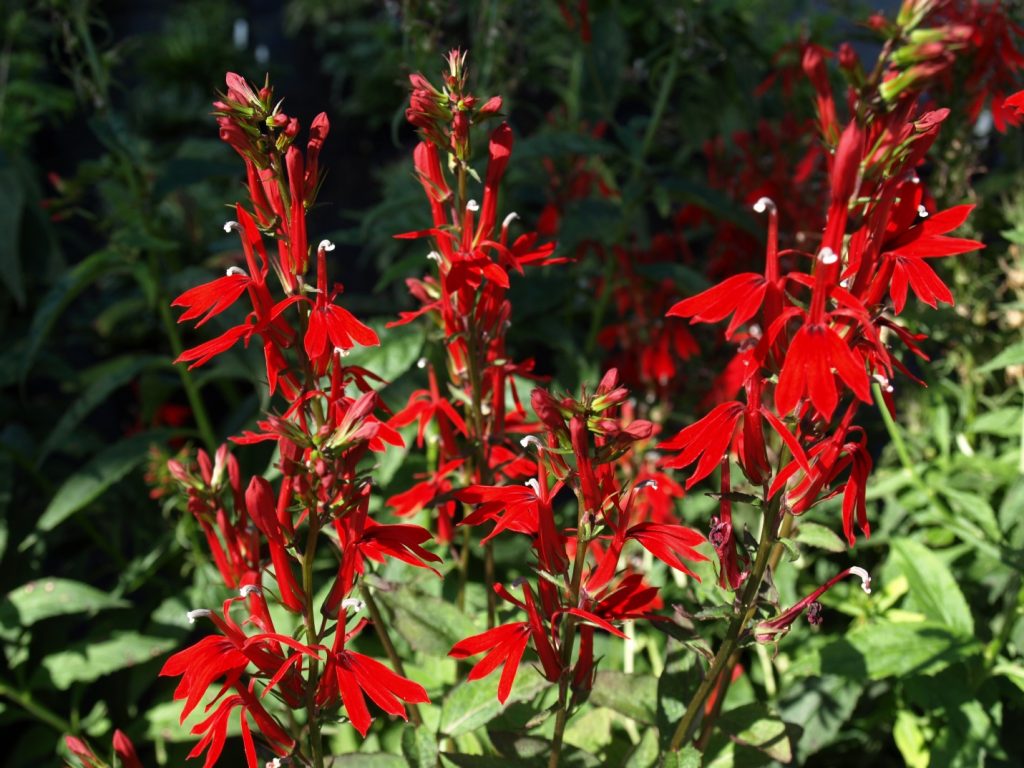
Cardinal flower, scientifically known as Lobelia cardinalis, displays long, vibrant red tubular flowers perfectly suited for hummingbirds’ feeding needs.
These herbaceous perennials bloom in late summer, featuring bright red flowers arranged on terminal spikes. Cardinal flowers are not drought-tolerant and prefer consistently moist soil.
When planting cardinal flowers in pots, it’s advisable to set them in trays of water that can be easily replenished.
Common Name: Cardinal Flower
Scientific Name: Lobelia cardinalis
Growing Zones: 3-9
Sun: Full sun to partial shade
Soil: Moist to wet
Colors: Red
Height: 2-4 feet
Spread: 1-2 feet
Plant Type: Perennial
16. Columbine
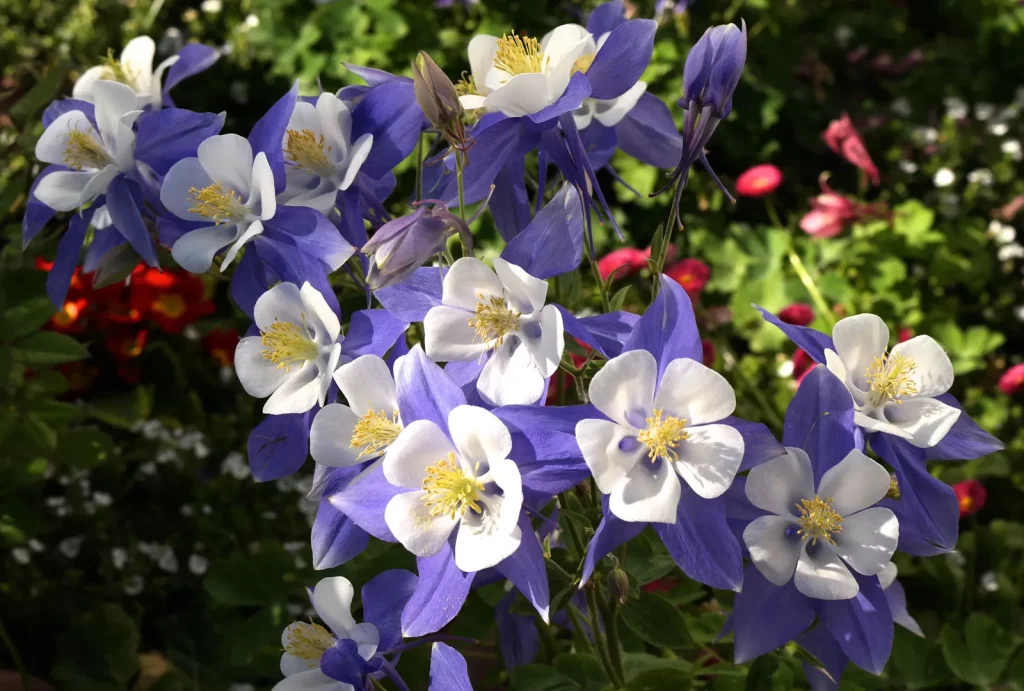
Columbine, scientifically known as Aquilegia, is a genus comprising approximately 70 species of flowering plants. These delicate and intricate flowers attract hummingbirds with their nectar-rich spurs.
Columbine plants produce unique flowers with spurred petals that come in a variety of colors, including shades of blue, purple, pink, yellow, and white. The spurred petals contain nectar, enticing hummingbirds and other pollinators.
These plants thrive in well-draining soil and prefer partial shade or filtered sunlight, especially in hotter climates. Columbines are self-seeding, and their seeds can be collected and saved for future plantings.
Common Name: Columbine
Scientific Name: Aquilegia
Growing Zones: 3-9
Sun: Partial shade to full shade
Soil: Well-drained
Colors: Blue, purple, pink, yellow, white
Height: 1-3 feet
Spread: 1-2 feet
Plant Type: Perennial
17. Red Hot Poker
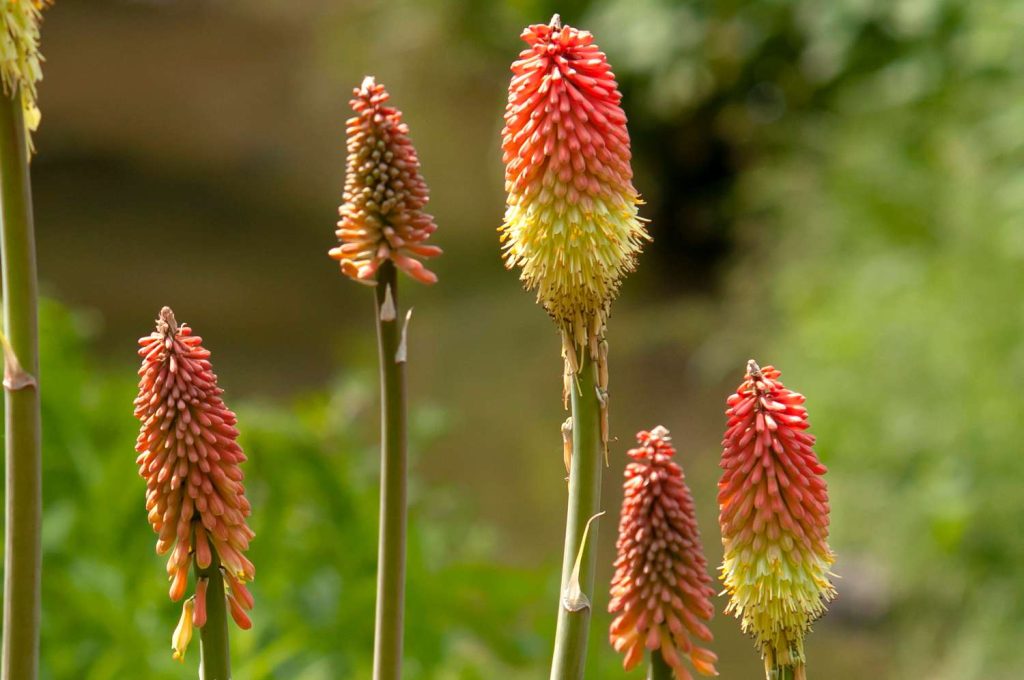
Red Hot Poker, scientifically known as Kniphofia, is a genus that comprises approximately 70 species of flowering plants native to Africa.
These plants are characterized by their tall flower spikes that resemble blazing torches, providing a visually striking addition to your garden. The bright, tubular flowers are typically red, orange, or yellow and are arranged densely on the spike. Red Hot Pokers are known for their ability to attract hummingbirds and butterflies.
These plants prefer full sun and well-drained soil. They are relatively low maintenance and can tolerate drought conditions. Deadheading spent flowers can encourage continuous blooming.
Common Name: Red Hot Poker, Torch Lily
Scientific Name: Kniphofia
Growing Zones: 5-10
Sun: Full sun
Soil: Well-drained
Colors: Red, orange, yellow
Height: 2-6 feet
Spread: 1-3 feet
Plant Type: Perennial
18. Lantana

Lantana is a genus that encompasses over 150 species of flowering plants, primarily native to tropical regions of the Americas and Africa.
These plants are known for their clusters of small, brightly colored flowers that bloom in a variety of hues, including shades of red, orange, yellow, pink, and purple. Lantana flowers produce nectar, attracting hummingbirds and butterflies to your garden.
Lantanas prefer full sun and well-drained soil. They are relatively drought-tolerant once established and can withstand hot and humid conditions. Regular deadheading promotes continuous blooming.
It’s important to note that some species of Lantana can be invasive in certain regions. It’s best to choose non-invasive varieties or consult with local gardening experts to ensure responsible planting.
Common Name: Lantana
Scientific Name: Lantana
Growing Zones: Varies by species (typically 8-11)
Sun: Full sun
Soil: Well-drained
Colors: Red, orange, yellow, pink, purple
Height: 1-6 feet
Spread: 2-6 feet
Plant Type: Perennial or annual, depending on species
19. Trumpet Vine
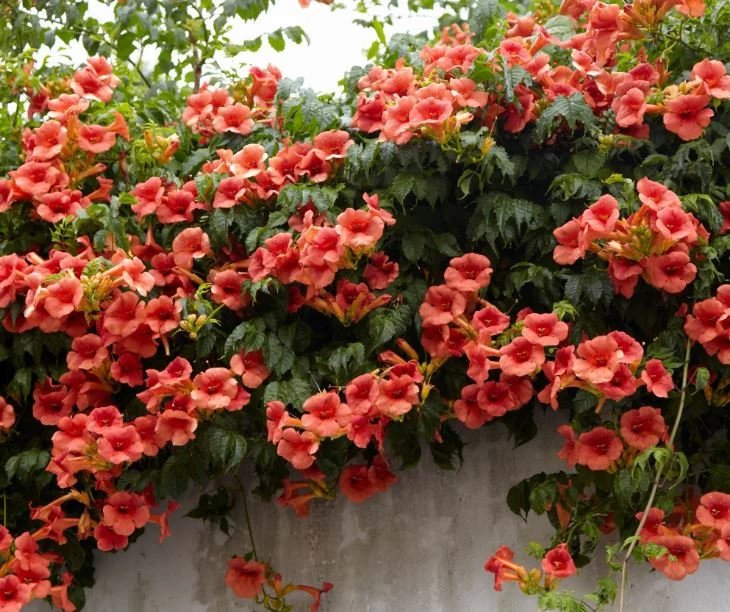
Trumpet vine, scientifically known as Campsis radicans, is a fast-growing, woody vine that produces trumpet-shaped flowers, ideal for attracting hummingbirds.
These vines feature clusters of tubular flowers that range in color from orange to red, creating a vibrant display in your garden. Trumpet vines are vigorous climbers and require sturdy support structures.
They prefer full sun to part shade and well-drained soil. Trumpet vines are adaptable and can tolerate a range of soil types. Pruning in late winter or early spring helps control their growth and promotes better flowering.
Common Name: Trumpet Vine, Trumpet Creeper
Scientific Name: Campsis radicans
Growing Zones: 4-9
Sun: Full sun to part shade
Soil: Well-drained
Colors: Orange, red
Height: Up to 40 feet
Spread: 5-10 feet
Plant Type: Perennial vine
20. Salvia
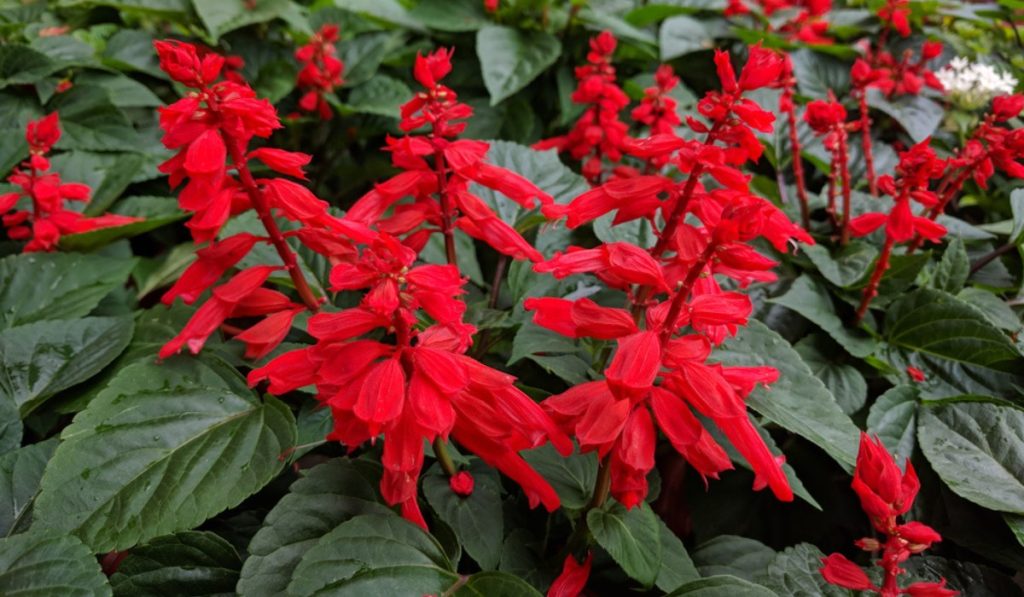
Salvia, a genus that includes numerous species of flowering plants, is a favorite among gardeners and hummingbirds alike. These plants are known for their vibrant, nectar-rich flowers that attract hummingbirds, bees, and butterflies.
Salvia flowers come in various colors, including shades of blue, purple, red, pink, and white. The tubular flowers are arranged in dense spikes, creating a stunning visual impact.
Salvias prefer full sun and well-drained soil. They are generally low maintenance and drought-tolerant once established. Deadheading spent flowers promotes prolonged blooming.
Common Name: Salvia
Scientific Name: Salvia
Growing Zones: Varies by species (typically 3-9)
Sun: Full sun
Soil: Well-drained
Colors: Blue, purple, red, pink, white
Height: Varies by species (typically 1-4 feet)
Spread: Varies by species
Plant Type: Perennial or annual, depending on species
21. Bee Balm
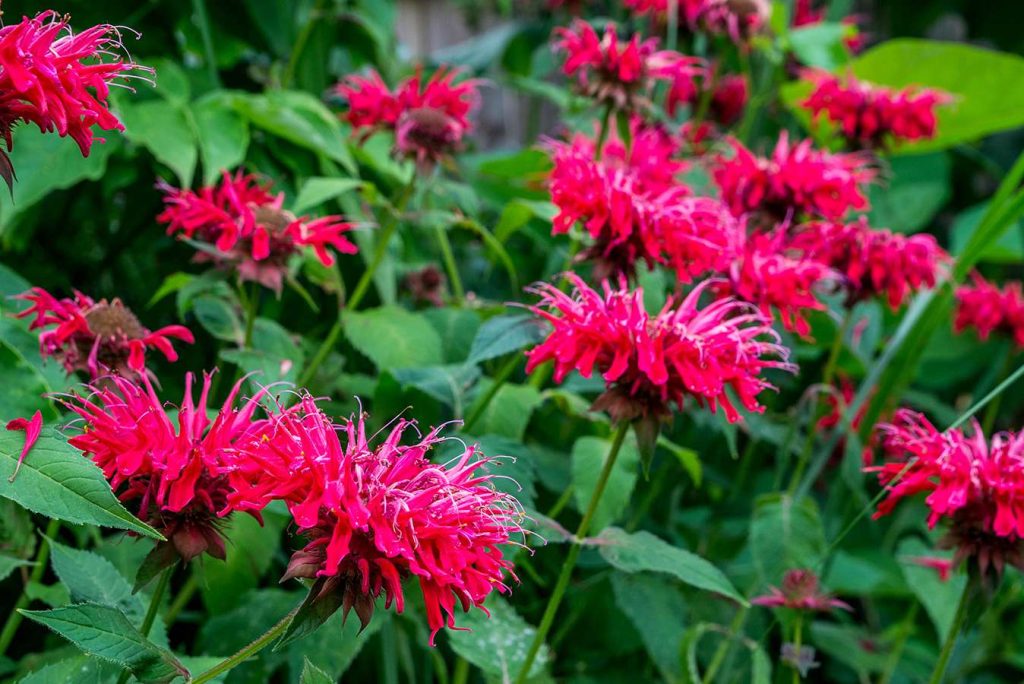
Bee Balm, scientifically known as Monarda, is a genus of flowering plants native to North America. These plants are highly attractive to hummingbirds, bees, and butterflies due to their vibrant and showy flowers.
Bee Balm flowers come in a range of colors, including shades of red, pink, purple, and white. The tubular flowers are clustered together in spherical or elongated heads, creating a striking display.
They thrive in full sun to part shade and prefer moist, well-drained soil. Bee Balm plants are prone to mildew, so adequate air circulation is important. Deadheading spent flowers can help prolong the blooming period.
Common Name: Bee Balm
Scientific Name: Monarda
Growing Zones: 3-9
Sun: Full sun to part shade
Soil: Moist, well-drained
Colors: Red, pink, purple, white
Height: 2-4 feet
Spread: 1-3 feet
Plant Type: Perennial
22. Fuchsia
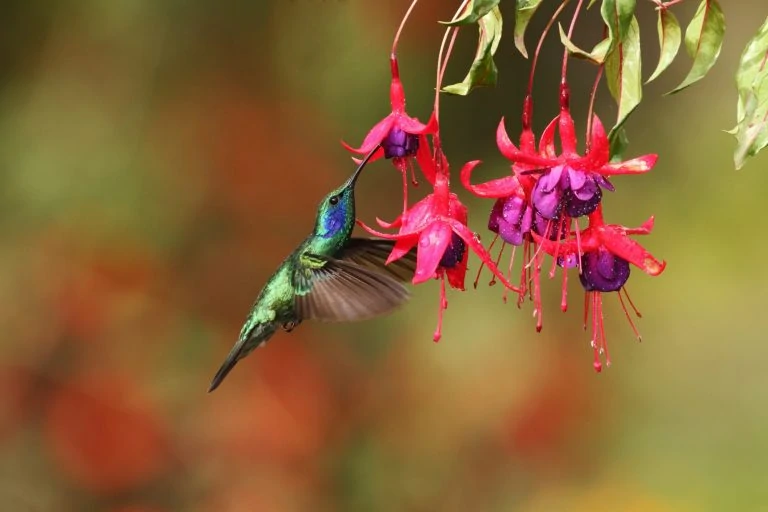
Fuchsia is a genus of flowering plants that includes both shrubs and trailing varieties. These plants produce unique, pendulous flowers that come in a wide range of colors, such as red, pink, purple, and white.
The tubular flowers of fuchsias are perfectly designed for hummingbirds, attracting them with their nectar-rich blooms. Fuchsias are popular container plants and can also be grown as hanging basket plants.
They prefer partial shade to full shade, as excessive sunlight can scorch their delicate foliage. Fuchsias thrive in well-drained, fertile soil that retains moisture. Regular watering is necessary to keep the soil consistently moist.
Common Name: Fuchsia
Scientific Name: Fuchsia
Growing Zones: Varies by species (typically 6-10)
Sun: Partial shade to full shade
Soil: Well-drained, fertile
Colors: Red, pink, purple, white
Height: Varies by species (typically 1-3 feet)
Spread: Varies by species
Plant Type: Perennial or annual, depending on species
23. Penstemon

Penstemon is a genus of flowering plants that encompasses numerous species, most of which are native to North America. These plants are renowned for their tubular flowers, which are highly attractive to hummingbirds.
Penstemon flowers come in a wide range of colors, including shades of blue, purple, red, orange, white, pink, and yellow. The tubular shape of the flowers is ideal for hummingbirds to access nectar.
They prefer full sun and well-drained soil. Penstemons are generally drought-tolerant once established but benefit from occasional watering during dry periods. Deadheading spent flowers can encourage additional blooming.
Common Name: Penstemon
Scientific Name: Penstemon
Growing Zones: Varies by species (typically 3-9)
Sun: Full sun
Soil: Well-drained
Colors: Blue, purple, red, orange, white, pink, yellow
Height: Varies by species
Spread: Varies by species
Plant Type: Perennial
24. Coral Bells
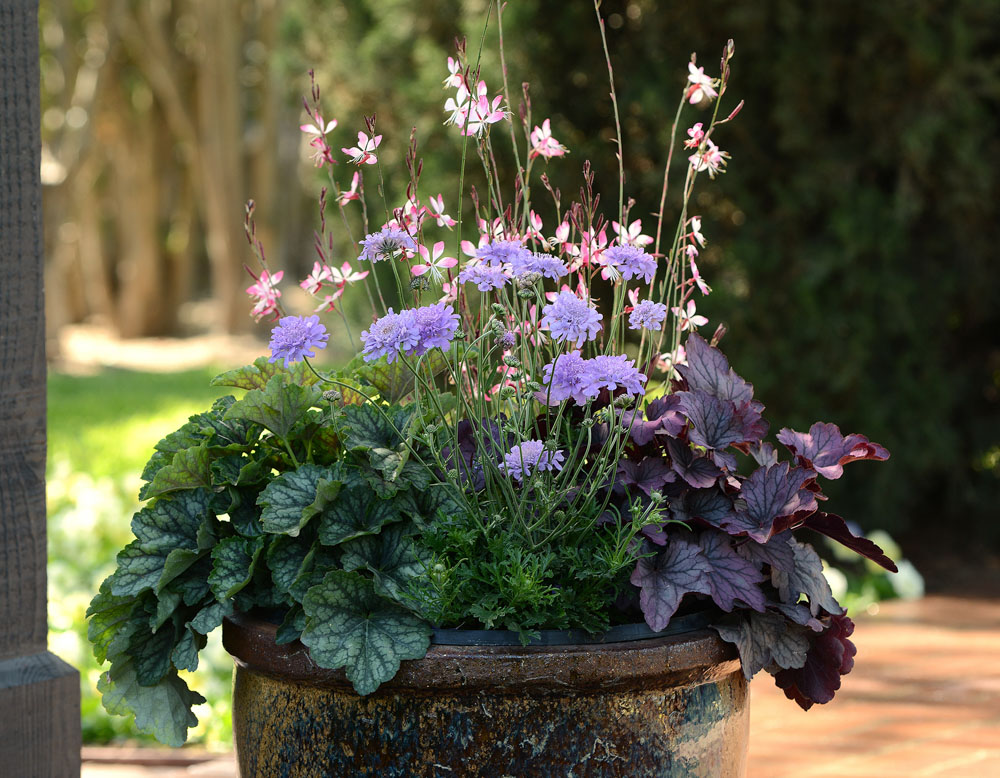
Coral Bells, scientifically known as Heuchera, are a genus of flowering plants prized for their attractive foliage and delicate flowers. While the flowers themselves may not be as prominent for hummingbird attraction, the nectar they produce can still entice hummingbirds.
Coral Bells produce small, bell-shaped flowers that come in various colors, including shades of red, pink, white, and coral. The true star of these plants is their vibrant, often variegated, foliage, which can be green, purple, silver, or bronze.
They prefer partial shade to full shade, especially in hotter regions, to protect their foliage from scorching. Coral Bells thrive in well-drained soil and require regular watering to keep the soil consistently moist.
Common Name: Coral Bells
Scientific Name: Heuchera
Growing Zones: Varies by species (typically 4-9)
Sun: Partial shade to full shade
Soil: Well-drained
Colors: Red, pink, white, coral
Height: Varies by species (typically 1-2 feet)
Spread: Varies by species
Plant Type: Perennial
25. Bleeding Heart
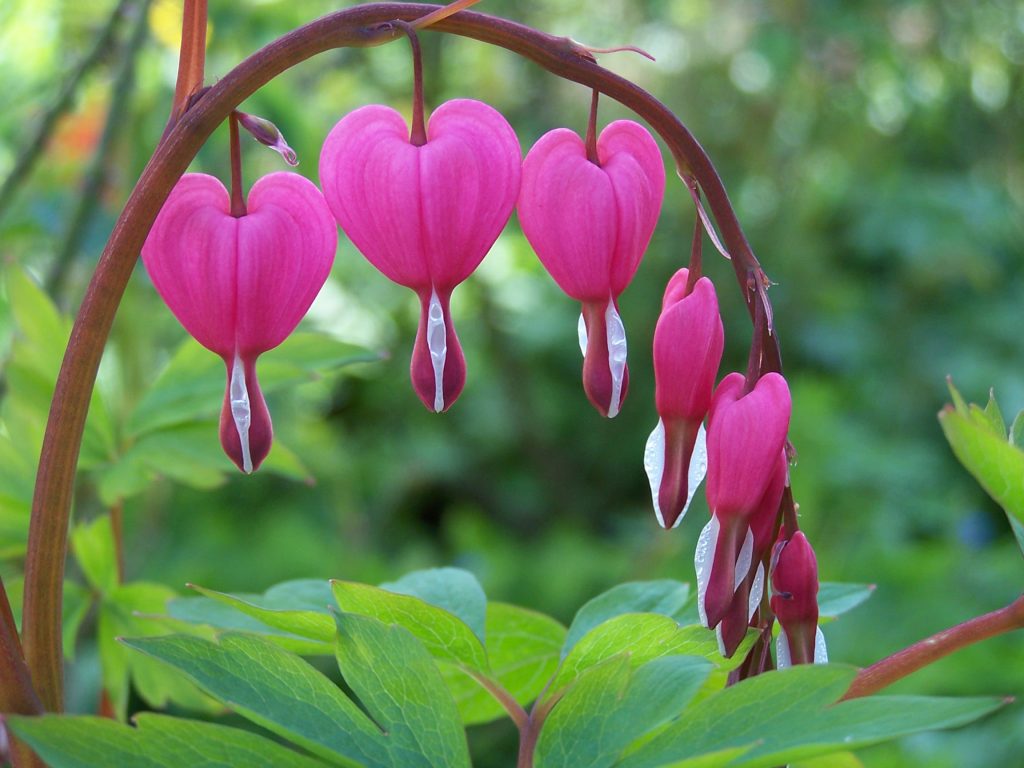
Bleeding Heart, scientifically known as Lamprocapnos or Dicentra, is a genus of flowering plants appreciated for their unique heart-shaped flowers. Although their flowers are not tubular, they can still attract hummingbirds with their nectar.
Bleeding Heart flowers are delicate and pendulous, typically in shades of pink or white. The distinct shape and arrangement of the flowers create an enchanting display in the garden.
They prefer partial shade to full shade, as excessive sunlight can cause their foliage to wilt. Bleeding Hearts thrive in well-drained soil with moderate moisture. Regular watering is necessary to keep the soil consistently moist.
Common Name: Bleeding Heart
Scientific Name: Lamprocapnos or Dicentra
Growing Zones: Varies by species (typically 3-9)
Sun: Partial shade to full shade
Soil: Well-drained
Colors: Pink, white
Height: Varies by species (typically 1-3 feet)
Spread: Varies by species
Plant Type: Perennial
26. Foxglove
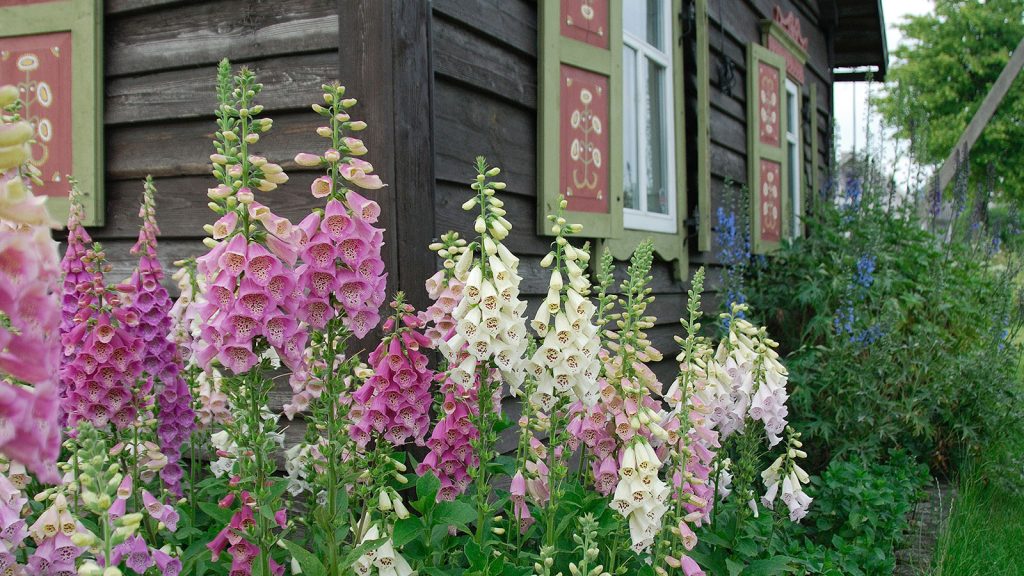
Foxglove, scientifically known as Digitalis, is a genus of flowering plants appreciated for their tall spikes of tubular flowers. While primarily known for their visual appeal, the nectar-rich flowers can attract hummingbirds.
Foxglove flowers come in various colors, including shades of pink, purple, white, and yellow. The distinctive tubular shape of the flowers makes them accessible to hummingbirds seeking nectar.
They prefer partial shade to full sun, depending on the region, and well-drained soil. Foxgloves are biennial or short-lived perennials, typically blooming in their second year. Deadheading spent flowers can encourage prolonged blooming.
Common Name: Foxglove
Scientific Name: Digitalis
Growing Zones: Varies by species (typically 4-8)
Sun: Partial shade to full sun
Soil: Well-drained
Colors: Pink, purple, white, yellow
Height: Varies by species (typically 2-5 feet)
Spread: Varies by species
Plant Type: Biennial or perennial, depending on species
27. Lobelia
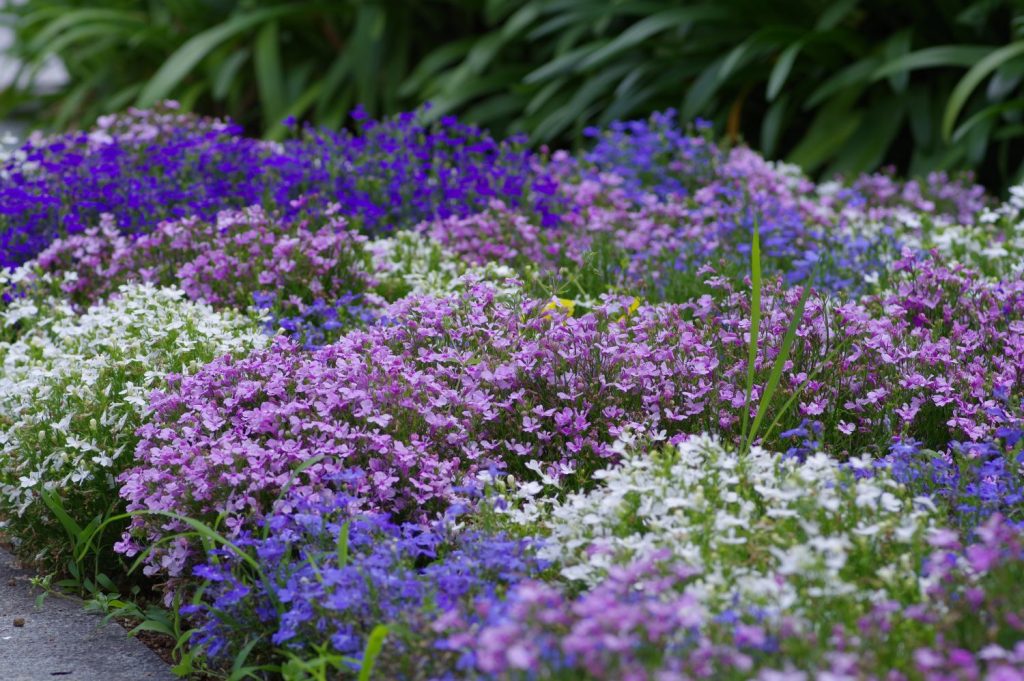
Lobelia is a genus of flowering plants that includes annuals, perennials, and shrubs. These plants produce vibrant, tubular flowers that are highly attractive to hummingbirds.
Lobelia flowers come in shades of blue, purple, pink, red, and white. The tubular shape of the flowers, coupled with their intense colors, makes them a magnet for hummingbirds.
They prefer full sun to partial shade and moist, well-drained soil. Regular watering is necessary to keep the soil consistently moist, as Lobelias do not tolerate drought well.
Common Name: Lobelia
Scientific Name: Lobelia
Growing Zones: Varies by species (typically 2-11)
Sun: Full sun to partial shade
Soil: Moist, well-drained
Colors: Blue, purple, pink, red, white
Height: Varies by species
Spread: Varies by species
Plant Type: Annual, perennial, or shrub, depending on species
28. Cardinal Flower
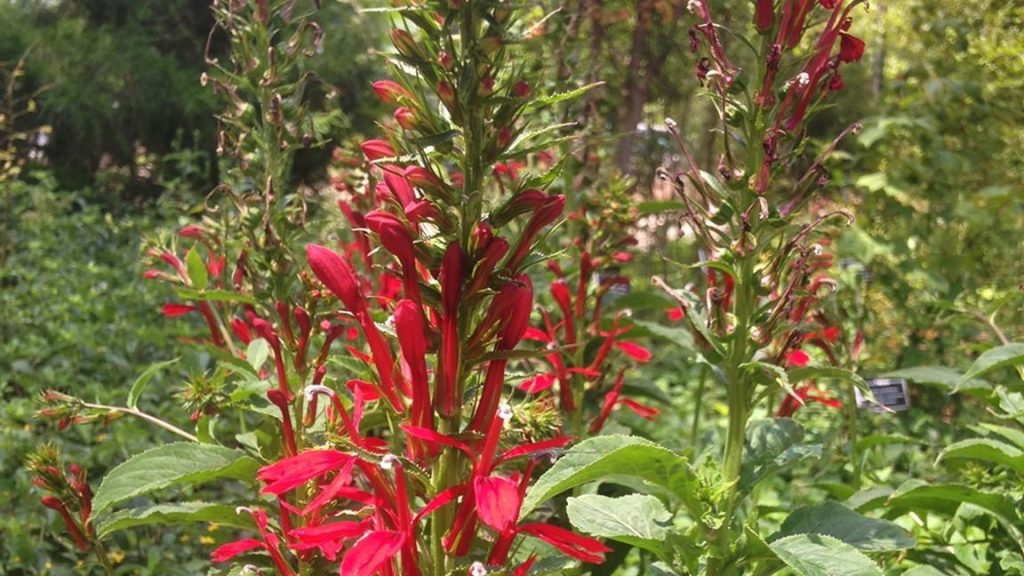
Cardinal Flower, scientifically known as Lobelia cardinalis, is a perennial plant native to North America. Its vibrant red tubular flowers are specifically adapted to attract hummingbirds.
Cardinal Flower produces tall spikes of flowers, typically in shades of vibrant red. The tubular shape and intense coloration of the flowers make them highly appealing to hummingbirds.
They prefer partial shade to full sun, especially in hotter regions, and moist, well-drained soil. Cardinal Flowers thrive in wetland or boggy areas and can tolerate soil that remains consistently moist.
Common Name: Cardinal Flower
Scientific Name: Lobelia cardinalis
Growing Zones: 2-9
Sun: Partial shade to full sun
Soil: Moist, well-drained
Colors: Red
Height: 2-4 feet
Spread: 1-2 feet
Plant Type: Perennial
29. Lantana
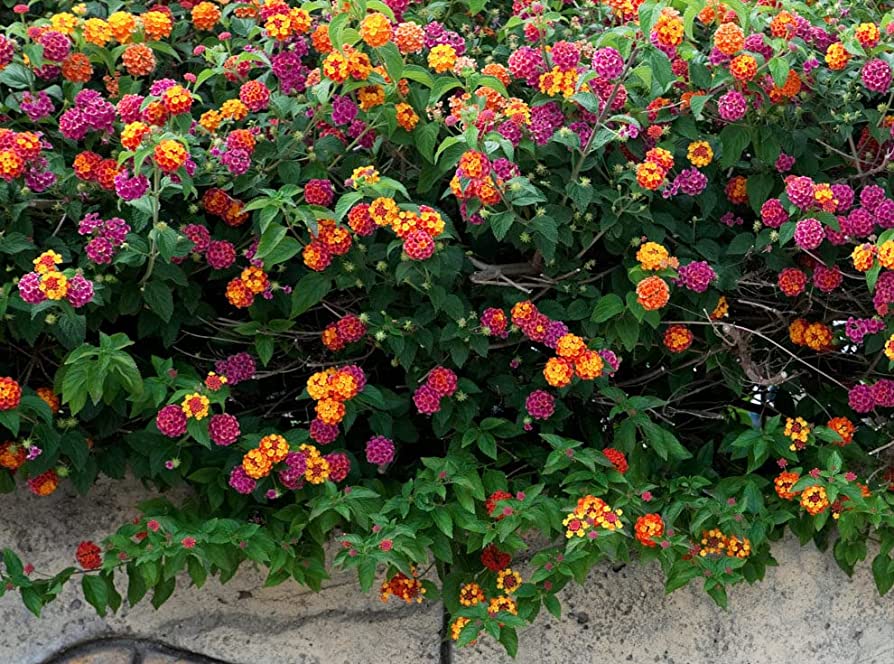
Lantana is a genus of flowering plants comprising both annuals and perennials. These plants are valued for their clusters of tubular flowers that change color as they mature, attracting hummingbirds and butterflies.
Lantana flowers come in various shades, including combinations of red, orange, pink, yellow, and white. The nectar-rich tubular flowers are arranged in dense clusters, creating a visually striking display.
They prefer full sun and well-drained soil. Lantanas are heat and drought-tolerant once established and can withstand challenging growing conditions. Regular deadheading can help promote continuous blooming.
Common Name: Lantana
Scientific Name: Lantana
Growing Zones: Varies by species (typically 8-11)
Sun: Full sun
Soil: Well-drained
Colors: Red, orange, pink, yellow, white
Height: Varies by species (typically 1-6 feet)
Spread: Varies by species
Plant Type: Annual or perennial, depending on species
30. Sage
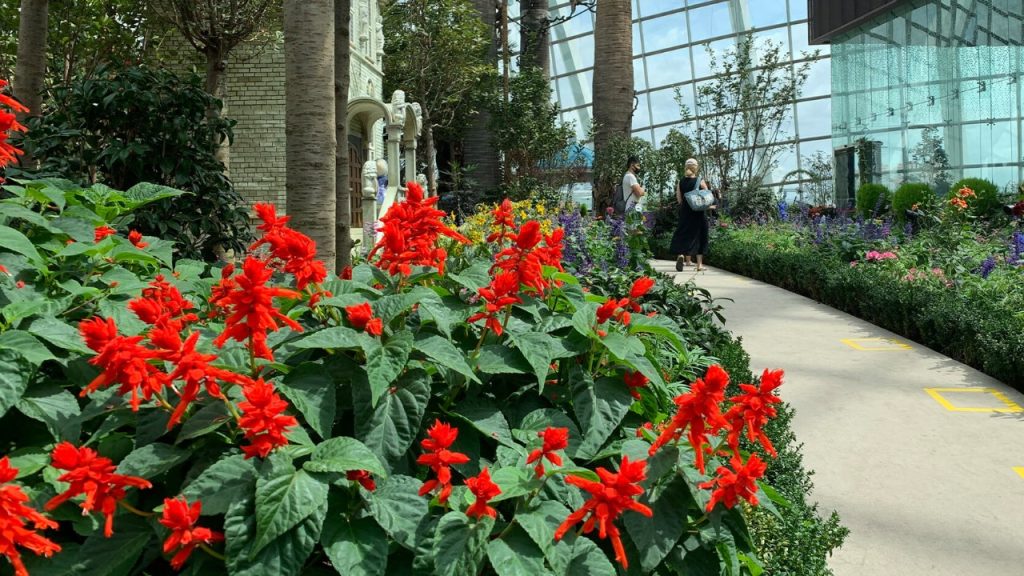
Sage, scientifically known as Salvia, is a diverse genus of flowering plants that includes both culinary herbs and ornamental varieties. The tubular flowers of many Salvia species are highly attractive to hummingbirds.
Sage flowers come in a range of colors, including shades of blue, purple, red, pink, and white. The tubular shape and abundant nectar make them irresistible to hummingbirds seeking nourishment.
They prefer full sun and well-drained soil. Sage plants are generally drought-tolerant once established and require minimal watering. Deadheading spent flowers can promote prolonged blooming.
Common Name: Sage
Scientific Name: Salvia
Growing Zones: Varies by species (typically 4-9)
Sun: Full sun
Soil: Well-drained
Colors: Blue, purple, red, pink, white
Height: Varies by species
Spread: Varies by species
Plant Type: Annual or perennial, depending on species
Please let me know if you would like to continue with the next set of flowers!